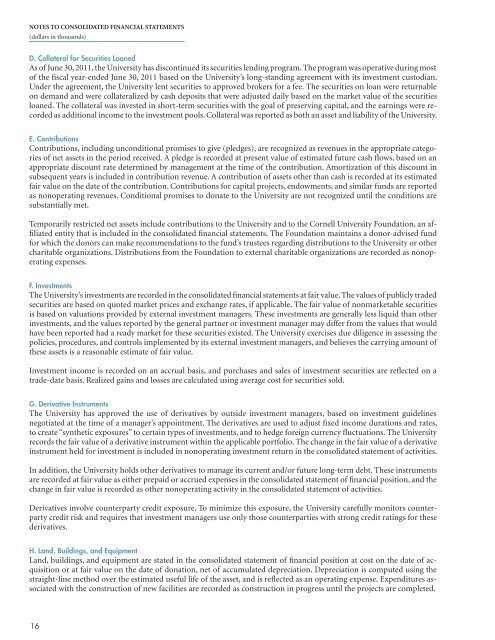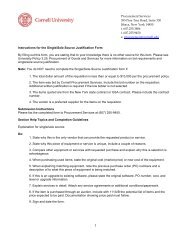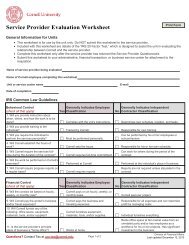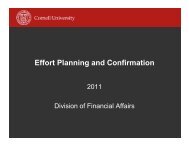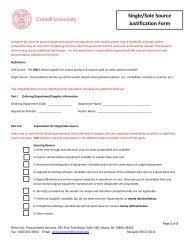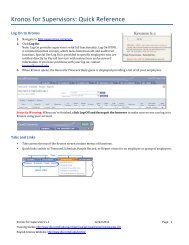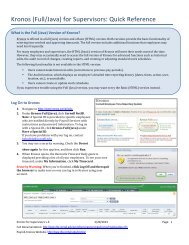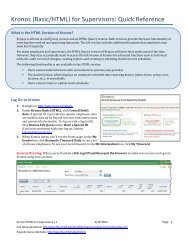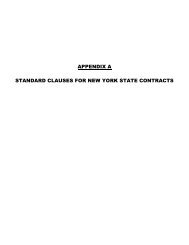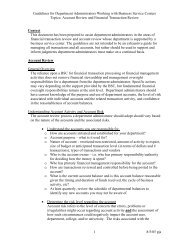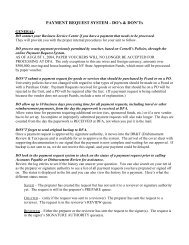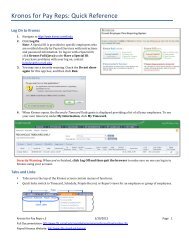Annual Report - DFA Home - Cornell University
Annual Report - DFA Home - Cornell University
Annual Report - DFA Home - Cornell University
Create successful ePaper yourself
Turn your PDF publications into a flip-book with our unique Google optimized e-Paper software.
NOTES TO CONSOLIDATED FINANCIAL STATEMENTS<br />
(dollars in thousands)<br />
D. Collateral for Securities Loaned<br />
As of June 30, 2011, the <strong>University</strong> has discontinued its securities lending program. The program was operative during most<br />
of the fiscal year-ended June 30, 2011 based on the <strong>University</strong>’s long-standing agreement with its investment custodian.<br />
Under the agreement, the <strong>University</strong> lent securities to approved brokers for a fee. The securities on loan were returnable<br />
on demand and were collateralized by cash deposits that were adjusted daily based on the market value of the securities<br />
loaned. The collateral was invested in short-term securities with the goal of preserving capital, and the earnings were recorded<br />
as additional income to the investment pools. Collateral was reported as both an asset and liability of the <strong>University</strong>.<br />
E. Contributions<br />
Contributions, including unconditional promises to give (pledges), are recognized as revenues in the appropriate categories<br />
of net assets in the period received. A pledge is recorded at present value of estimated future cash flows, based on an<br />
appropriate discount rate determined by management at the time of the contribution. Amortization of this discount in<br />
subsequent years is included in contribution revenue. A contribution of assets other than cash is recorded at its estimated<br />
fair value on the date of the contribution. Contributions for capital projects, endowments, and similar funds are reported<br />
as nonoperating revenues. Conditional promises to donate to the <strong>University</strong> are not recognized until the conditions are<br />
substantially met.<br />
Temporarily restricted net assets include contributions to the <strong>University</strong> and to the <strong>Cornell</strong> <strong>University</strong> Foundation, an affiliated<br />
entity that is included in the consolidated financial statements. The Foundation maintains a donor-advised fund<br />
for which the donors can make recommendations to the fund’s trustees regarding distributions to the <strong>University</strong> or other<br />
charitable organizations. Distributions from the Foundation to external charitable organizations are recorded as nonoperating<br />
expenses.<br />
F. Investments<br />
The <strong>University</strong>’s investments are recorded in the consolidated financial statements at fair value. The values of publicly traded<br />
securities are based on quoted market prices and exchange rates, if applicable. The fair value of nonmarketable securities<br />
is based on valuations provided by external investment managers. These investments are generally less liquid than other<br />
investments, and the values reported by the general partner or investment manager may differ from the values that would<br />
have been reported had a ready market for these securities existed. The <strong>University</strong> exercises due diligence in assessing the<br />
policies, procedures, and controls implemented by its external investment managers, and believes the carrying amount of<br />
these assets is a reasonable estimate of fair value.<br />
Investment income is recorded on an accrual basis, and purchases and sales of investment securities are reflected on a<br />
trade-date basis. Realized gains and losses are calculated using average cost for securities sold.<br />
G. Derivative Instruments<br />
The <strong>University</strong> has approved the use of derivatives by outside investment managers, based on investment guidelines<br />
negotiated at the time of a manager’s appointment. The derivatives are used to adjust fixed income durations and rates,<br />
to create “synthetic exposures” to certain types of investments, and to hedge foreign currency fluctuations. The <strong>University</strong><br />
records the fair value of a derivative instrument within the applicable portfolio. The change in the fair value of a derivative<br />
instrument held for investment is included in nonoperating investment return in the consolidated statement of activities.<br />
In addition, the <strong>University</strong> holds other derivatives to manage its current and/or future long-term debt. These instruments<br />
are recorded at fair value as either prepaid or accrued expenses in the consolidated statement of financial position, and the<br />
change in fair value is recorded as other nonoperating activity in the consolidated statement of activities.<br />
Derivatives involve counterparty credit exposure. To minimize this exposure, the <strong>University</strong> carefully monitors counterparty<br />
credit risk and requires that investment managers use only those counterparties with strong credit ratings for these<br />
derivatives.<br />
H. Land, Buildings, and Equipment<br />
Land, buildings, and equipment are stated in the consolidated statement of financial position at cost on the date of acquisition<br />
or at fair value on the date of donation, net of accumulated depreciation. Depreciation is computed using the<br />
straight-line method over the estimated useful life of the asset, and is reflected as an operating expense. Expenditures associated<br />
with the construction of new facilities are recorded as construction in progress until the projects are completed.<br />
16


